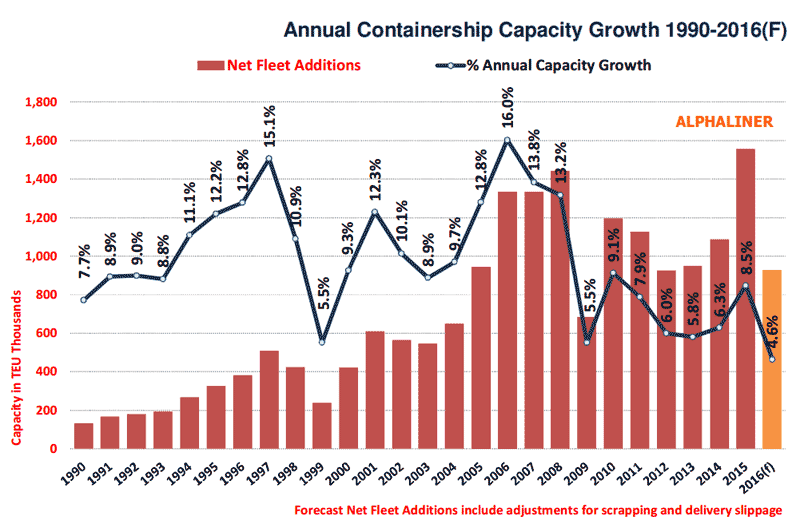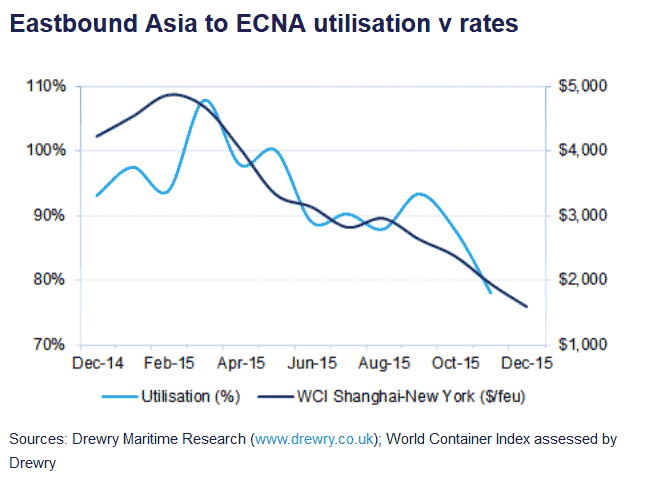Maersk CEO Modestly Optimistic on Volumes, but the New Ships Keep Coming
Global ocean container carriers simply have not been able to achieve discipline in the growth of capacity, which has far exceed volume growth in recent years, leading to a generally lousy pricing environment for carriers, and a great one for ocean shippers.
That trend is likely to continue on, even though estimates from the analysts at Alphaliner show that the growth in container ship capacity worldwide will be the lowest since the firm started tracking such matters in 1990.
As can be seen in the chart below, Alphaliner predicts net capacity - considering new ship deliveries and planned scrapping of existing ships and laying up others - will grow 4.6% in 2016, far below the growth of 8.5% last year, and even less than the 5.5% growth seen in 2009 in the midst of the Great Recession. However, that 4.6% rate will still result in new capacity of almost 800,000 TEU - roughly equivalent to about 45 new 18,000 TEU megaships.
Since 1990, the total cumulative growth of ocean container capacity in terms of TEU has been 10.3%.
Of course, the ocean container industry has been plagued by over capacity for a number of years, leading to collapsing rates and big losses by many carriers. Nearly all major carriers - led by Maersk Lines - have tried to address the bottom line by investing in ever larger ships (18,000+ TEU capacity) that offer the potential for much lower operating costs per container, but have been adding those types of ships to their fleets without laying up or scrapping ships of equal total capacity So total industry capacity continues to grow - and consistently much faster than container volume growth.
And while the growth in industry capacity will slow in 2016, it will still be several percentage points above volume growth.
Last week, Nils Andersen, CEO of Maersk Lines' parent company A.P. Møller-Mærsk, said that the company expects to see container volume growth of a decent 3% in 2016 - triple the weak 1% growth that was achieved in 2015 (again, versus capacity growth of 8.5% last year).

Source: Alphaliner
But that may be optimistic - an analyst at Braemar ACM Shipbroking said last week he expects container demand to grow at most 1.5% this year, the lowest since 2009. If he is right, the 4.6% growth in capacity would still be three times the growth in container volumes, moving the supply-demand balance even more in the favor of shippers.
Which of course means rates will stay low and maybe fall even further. Rates from Asia to Europe were as high as $1,765 per TEU at the start of 2014, but fell to fell to an average of just $620 per container in 2015. Rates to the US from Asia have held up slightly better, but not by much.
| |||||||||
And rates are also slumping badly on routes from Asia to the East Coast of the United States. The analysts at Drewry say a year ago, the cost for shipping a 40-foot container from Shanghai to the port of New York was more than $4500, as US importers were moving a lot of volume from Asia to the East Coast instead of the West Coast, due to the labor chaos and big logjams seen at the ports of Los Angeles and Long Beach as well as others.
Now, that rate from China to New York has fallen by almost 50%, to about $2500. And that is simply because of supply and demand, as utilization on China to New York routes has fallen from more than 100% a year ago to under 80% in recent months, as shown in the figure below.
 So it seems clear the capacity glut in container shipping will remain for all of 2016, as ocean shippers await the impact of the expanded Panama Canal when it opens sometime this year. |
Monday, January 25, 2016
Subscribe to:
Post Comments (Atom)
No comments:
Post a Comment